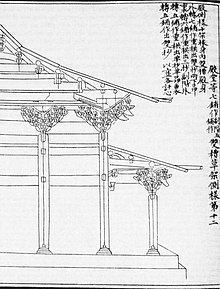| Yingzao Fashi | |||||||||
|---|---|---|---|---|---|---|---|---|---|
| Traditional Chinese | 營造法式 | ||||||||
| Simplified Chinese | 营造法式 | ||||||||
| Literal meaning | "Treatise on Architectural Methods or State Building Standards" | ||||||||
| |||||||||

The Yingzao Fashi (Chinese: 營造法式; pinyin: yíngzàofǎshì; lit. 'Treatise on Architectural Methods or State Building Standards') is a technical treatise on architecture and craftsmanship written by the ancient Chinese author Li Jie (李誡; 1065–1110),[1] the Directorate of Buildings and Construction during the mid Song Dynasty of China. He revised many older treatises on architecture from 1097 to 1100. By 1100, he had completed his own architectural work, which he presented to Emperor Zhezong of Song.[2][3] The emperor's successor, Emperor Huizong of Song, had the book published in 1103 to provide architectural standards for builders, architects, literate craftsmen, and the engineering agencies of the central government.[2][3][4] Li Jie was then made the Director of Palace Buildings.[5] Thereafter, Li helped oversee the construction of administrative offices, palace apartments, gates and gate-towers, the ancestral temple of the Song Dynasty, along with numerous Buddhist temples.[3]
In 1145, a second edition of Li's book was published by Wang Huan.[4] Between 1222-1233, a third printing was published. This edition, published in Pingjiang (now Suzhou, Jiangsu), was later handcopied into the Yongle Encyclopedia and Siku Quanshu. In addition, a number of handcopied editions were made for private libraries. One of these handcopies of the Pingjiang edition was rediscovered in 1919 and printed as facsimile in 1920.
- ^ Guo (1998), p. 1-3.
- ^ a b Guo (1998), p. 4.
- ^ a b c Needham et al. (1986), p. 84.
- ^ a b Guo (1998), p. 6.
- ^ Guo (1998), p. 5.